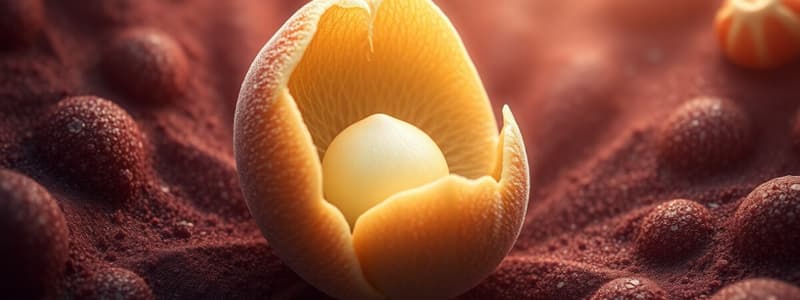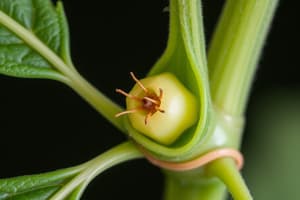Podcast
Questions and Answers
What role do phytohormones play in seed dormancy?
What role do phytohormones play in seed dormancy?
- They balance synthesis and degradation to regulate germination. (correct)
- They exclusively promote germination.
- They have no impact on dormancy or germination.
- They only inhibit respiration during dormancy.
What is the first visible sign of seed germination?
What is the first visible sign of seed germination?
- Swelling of the seed and emergence of the radicle. (correct)
- Activation of the aleurone layer.
- Complete breakdown of the endosperm.
- Emergence of the cotyledons.
Which type of respiration is initially activated in seeds during germination?
Which type of respiration is initially activated in seeds during germination?
- Cellular respiration.
- Aerobic respiration.
- Fermentation.
- Anaerobic respiration. (correct)
Which component of the seed is responsible for the initial digestion of the endosperm?
Which component of the seed is responsible for the initial digestion of the endosperm?
What distinguishes a simple fruit from other types of fruits?
What distinguishes a simple fruit from other types of fruits?
Which hormone is primarily associated with inhibiting seed germination?
Which hormone is primarily associated with inhibiting seed germination?
What is the function of the aleurone layer in cereals during germination?
What is the function of the aleurone layer in cereals during germination?
Which part of the fruit surrounds the seeds?
Which part of the fruit surrounds the seeds?
What is the primary function of the seed?
What is the primary function of the seed?
What distinguishes albuminous seeds from exalbuminous seeds?
What distinguishes albuminous seeds from exalbuminous seeds?
During embryo development, what is the first stage that follows polar cellular division?
During embryo development, what is the first stage that follows polar cellular division?
What contributes to the formation of the endosperm?
What contributes to the formation of the endosperm?
Which factor is NOT commonly associated with overcoming seed dormancy?
Which factor is NOT commonly associated with overcoming seed dormancy?
Which seed type is an example of an albuminous seed?
Which seed type is an example of an albuminous seed?
What is the role of the suspensor during embryo development?
What is the role of the suspensor during embryo development?
How does the appearance of a gymnosperm embryo differ from that of a dicot?
How does the appearance of a gymnosperm embryo differ from that of a dicot?
What is the primary distinguishing feature of compound fruits?
What is the primary distinguishing feature of compound fruits?
Which of the following is an example of a multiple fruit?
Which of the following is an example of a multiple fruit?
What role does ethylene play in fruit ripening?
What role does ethylene play in fruit ripening?
How does dehiscent fruit differ from indehiscent fruit?
How does dehiscent fruit differ from indehiscent fruit?
Which fruit type has a thick, leathery exocarp?
Which fruit type has a thick, leathery exocarp?
What defines a caryopsis?
What defines a caryopsis?
Which example best describes an achene?
Which example best describes an achene?
Which characteristic is true for nuts?
Which characteristic is true for nuts?
Flashcards are hidden until you start studying
Study Notes
Seeds
- The primary function of the seed is to protect the embryo.
- The embryo is the product of the fusion of sperm and egg.
- The egg provides the cytoplasm and organelles.
- The endosperm is triploid and very active.
- After formation, it will divide rapidly and go through a coenocytic stage.
- The endosperm forms via many nuclear divisions and cytoplasmic thickening.
Embryo Development
- The embryo forms by both nuclear and cellular divisions.
- The embryo divides via asymmetrical division.
- The basal cell and apical cell have polarity.
- The development of the suspensor anchors the embryo.
- The next stages are the globular stage, the heart, and the torpedo.
- These stages are based on the appearance of the embryo in dicots.
- The monocot embryo has a different appearance to the dicot.
- The gymnosperm embryo looks similar to the dicot, except that it has many more cotyledons.
Seed Types
- Seeds can be described as albuminous and exalbuminous.
- The difference is whether there is nutritive material surrounding the developing embryo.
- The castor bean and corn are albuminous, and the common bean is exalbuminous.
- Gymnosperm seeds can be considered albuminous.
- The nutritive gymnosperm tissue is largely megagametophyte tissue.
Seed Coat (Testa)
- The testa is composed of parenchyma and sclerids.
Dormancy
- Dormancy mechanisms can be overcome with the appropriate scarification methods.
- Most involve a combination of temperature and moisture variation, which is often referred to as vernalization.
- Other mechanisms require physical disturbance of the testa, which can include burning, exposure to acid, or physical scraping.
- The ABA/GA response model centers on the relative amounts of the phytohormones present in the seed tissue.
- The balance between the synthesis of one and the degradation of the other can trigger or inhibit the germination response.
Germination
- Seed needs to be imbibed to "wake up" the embryo and break dormancy.
- Germination begins when the embryo starts to respire.
- The embryo will be involved in the digestion of the endosperm via the release of hydrolytic enzymes.
- Usually the first visible signs are swelling of the seed and emergence of the radicle as it ruptures the seed coat.
- Activation of the seed metabolism involves anaerobic respiration at first, as well as the PPP and Beta oxidation.
- Mobilization of enzymes and stored nutrients is vital.
- The aleurone in cereals is activated.
- Exalbuminous dicots use metabolites in cotyledons.
- Rapid cell division occurs in the hypocotyl and epicotyl, which causes the emergence of the radicle.
Establishment of the Stele
- The establishment of the stele is the final step in seed germination.
Hypogeal Germination
- In hypogeal germination, the cotyledons remain below the ground.
Epigeal Germination
- In epigeal germination, the cotyledons are pulled above the ground.
Conifer Seed Emergence
- The seed of the gymnosperm represents three generations of the life cycle.
- The seed coat is derived from the integuments of the sporophyte (2n), which encases the megagametophyte (n), which surrounds the embryo (2n).
Fruit
- Fruit is a modification of the ovary or receptacle wall.
- Most fruit is specialized to facilitate seed dispersal.
- When fruit forms, the other floral organs wither away.
- The walls differentiate into three distinct layers:
- Endocarp - the innermost layer surrounds the seeds.
- Mesocarp - the fleshy middle layer.
- Exocarp - the outer layer, skin, or peel.
- The pericarp is all of the layers together.
Fruit Terminology
- True fruit is derived only from ovarian tissue.
- Accessory fruit is derived from other tissues besides ovarian tissue.
- Simple fruit is derived from one ovary from one flower.
- Compound fruit can be aggregate, which is separate carpels from a single gynoecium fusing together.
- Compound fruit can be multiple, which is individual fruits from an inflorescence fusing together.
- Fleshy fruits have a pericarp that is edible and usually eaten during seed distribution.
- Dry fruits have a pericarp that is not usually eaten.
- Dehiscent fruits break open and release seeds.
- Indehiscent fruits must be cracked open to release seeds.
Fruit Seed Dispersal
- Many fruits do not open when mature, and are simply eaten or decompose.
- Dehiscent fruits will rupture on their own, but with specific patterns.
- These patterns are used to describe fruit types.
Fruit Ripening
- Developing fruit pass through a series of programmed stages.
- Fruit goes through two stages of division and expansion (filling).
- The ripening process is influenced by ethylene, a gaseous plant growth regulator (hormone).
- The stages of starch accumulation and decline are influenced by the maturation of the seed.
- Starch degradation will lead to the accumulation of simple sugars like fructose.
Fleshy Fruits
- Berry - Simple fruit with a fleshy pericarp derived from a single ovary; seeds are dispersed in the pulp.
- Pome - Similar to berry by the exocarp is papery or leathery; the fleshy part of the fruit is derived from the hypanthium.
- Drupe - Similar to berry, but the endocarp is sclerenchymous; called stone fruits.
- Pepo - A fleshy fruit where the exocarp is tough or hard; the inner layers may not be differentiated.
- Hesperidium - Simple fruit with a thick and leathery exocarp.
- Hip (Semi-fleshy) - Separate carpels enclosed by a fleshy receptable/hypanthium.
Dry Indehiscent Fruit
- Caryopsis - Simple small indehiscent fruit; contains one seed, and the testa is fused to the pericarp.
- Achene - Indehiscent fruit like the caryopsis, but the fruit and seed remain distinct.
- Anthocarp - Similar to achene, but the perianth and receptacle are fused.
- Samara - A one-seeded fruit with winged outgrowths of the ovary wall.
- Nut - Usually from a compound gynoecium.
- Nut with Involucre - Chestnuts and hazelnuts.
- Tryma - Nut-like drupe.
- Utricle - Single-seeded bladders with thin walls.
Studying That Suits You
Use AI to generate personalized quizzes and flashcards to suit your learning preferences.




